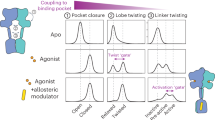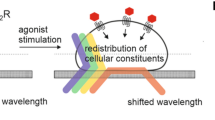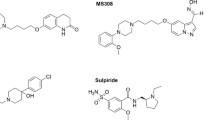Abstract
Evidence has been obtained for adenosine/dopamine interactions in the central nervous system. There exists an anatomical basis for the existence of functional interactions between adenosine A1R and dopamine D1R and between adenosine A2A and dopamine D2 receptors in the same neurons. Selective A1R agonists affect negatively the high affinity binding of D1 receptors. Activation of A2A receptors leads to a decrease in receptor affinity for dopamine agonists acting on D2 receptors, specially of the high-affinity state. These interactions have been reproduced in cell lines and found to be of functional significance. Adenosine/dopamine interactions at the behavioral level probably reflect those found at the level of dopamine receptor binding and transduction. All these findings suggest receptor subtype-specific interactions between adenosine and dopamine receptors that may be achieved by molecular interactions (e.g., receptor heterodimerization). At the molecular level adenosine receptors can serve as a model for homomeric and heteromeric protein–protein interactions. A1R forms homodimers in membranes and also form high-order molecular structures containing also heterotrimeric G-proteins and adenosine deaminase. The occurrence of clustering also clearly suggests that G-protein- coupled receptors form high-order molecular structures, in which multimers of the receptors and probably other interacting proteins form functional complexes. In view of the occurrence of homodimers of adenosine and of dopamine receptors it is speculated that heterodimers between these receptors belonging to two different families of G-protein-coupled receceptors can be formed. Evidence that A1/D1 can form heterodimers in cotransfected cells and in primary cultures of neurons has in fact been obtained. In the central nervous system direct and indirect receptor–receptor interactions via adaptor proteins participate in neurotransmission and neuromodulation and, for example, in the establishment of high neural functions such as learning and memory.
Similar content being viewed by others
Log in or create a free account to read this content
Gain free access to this article, as well as selected content from this journal and more on nature.com
or
References
Agnati L, Fuxe K, Zoli M, Rondanini C, Ogren SO . (1982): New vistas on synaptic plasticity: mosaic hypothesis of the engram. Med Biol 60: 183–190
Agnati L, Benfenati F, Solfrini V, Biagini G, Fuxe K, Guidolin D, Carani C, Zini I . (1993): Intramembrane receptor–receptor interactions: intergration of signal transduction pathways in the nervous system. Neurochem Int 22: 213–222
Brakeman PR, Lanahan AA, O'Brien R, Roche K, Barnes CA, Huganir RL, Worley PF . (1997): Homer: a protein that selectively binds metabotropic glutamate receptors. Nature 386: 284–288
Casadó V, Cantıacute; C, Mallol J, Canela EI, Lluis C, Franco R . (1990): Solubilization of A1 adenosine receptor from pig brain: characterization and evidence of the role of the cell membrane on the coexistence of high- and low-affinity states. J Neurosc Res 26: 461–473
Changeux J-P, Edelstein SJ . (1998): Allosteric receptors after 30 years. Neuron 21: 959–980
Ciruela F, Casadó V, Mallol J, Canela EI, Lluis C, Franco R . (1995): Immunological identification of A1 adenosine receptors in brain cortex. J Neurosc Res 42: 818–828
Ciruela F, Saura C, Canela EI, Mallol J, Lluis C, Franco R . (1996): Adenosine deaminase affects ligand-induced signalling by interacting with cell surface adenosine receptors. FEBS Lett 380: 219–223
Conn PM, Rogers DC, McNeil R . (1982): Potency enhancement of a GnRH agonist: GnRH-receptor microaggregation stimulates gonadotropin release. Endocrinology 111: 335–337
Cvejic S, Devi LA . (1997): Dimerization of the delta opioid receptor: implication for a role in receptor internalization. J Biol Chem 272: 26959–26964
Dasgupta S, Ferré S, Kull B, Hedlund P, Finnman V, Ahlberg S, Arenas E, Fredholm BB, Fuxe K . (1996): Adenosine A2A receptors modulate the binding characteristics of dopamine D2 receptors in stably cotransfected fibroblast cells. Eur J Pharmacol 316: 325–331
Ferré S, von Euler G, Johansson B, Fredholm BB, Fuxe K . (1991): Stimulation of high affinity adenosine A-2 receptors decreases the affinity of dopamine D-2 receptors in rat striatal membranes. Proc Natl Acad Sci USA 88: 7238–7241
Ferré S, Fuxe K, von Euler G, Johansson B, Fredholm BB . (1992): Adenosine-dopamine interactions in the brain. Neuroscience 51: 501–512
Ferré S, O'Connor WT, Fuxe K, Ugerstedt U . (1993): The striopallidal neuron: a main locus for adenosine-dopamine interactions in the brain. J Neurosc 13: 5402–5406
Ferré S, Fredholm BB, Morelli M, Popoli P, Fuxe K . (1997): Adenosine-dopmaine interactions as an integrative mechanism in the basal ganglia. Trends Neurosc 20: 482–487
Ferré S, Torvinen M, Antoniou K, Irenius E, Civelli O, Arenas E, Fredholm BB, Fuxe K . (1998): Adenosine A1 receptor-medaited modulation of dopamine D1 receptors in stably cotransfected fibroblasts cells. J Biol Chem 273: 4718–4724
Franco R, Casadó V, Ciruela F, Mallol J, Lluis C, Canela EI . (1996): The cluster-arranged cooperative model: a model that accounts for the binding kinetics to A1 adenosine receptors. Biochemistry 35: 3007–3015
Franco R, Casadó V, Ciruela F, Saura C, Mallol J, Canela EI, Lluis C . (1997): Cell surface adenosine deaminase: much more than an ectoenzyme. Prog Neurobiol 52: 283–294
Fredholm BB, Abbracchio MP, Burnstock G, Daly JW, Harden TK, Jacobson KA, Leff P, Williams M . (1994): Nomenclature and classification of purinoceptors. Pharmacol Rev 46: 143–156
Fredholm BB . (1995): Adenosine, adenosine receptors and the actions of caffeine. Pharmacol Toxicol 76: 93–101
Fuxe K, Agnati L . (1987): Receptor-receptor interactions. Wenner-Gren Center International Symposium Series. Southampton, MacMillan Press.
Fuxe K, Agnati LF, Benfenati F, Celani M, Zini I, Zoli M, Mutt V . (1983): Evidence for the existence of receptor–receptor interactions in the central nervous system. Studies on the regulation of monoamine receptors by neuropeptides. J Neur Transm 18: 165–179
Ginés S, Hillion J, Torvinen M, Le Crom S, Casado V, Canela EI, Rondin S, Lew JY, Watson S, Zoli M, Agnati L, Vernier P, Lluis C, Ferré S, Fuxe K, Franco R . (2000): Dopamine D1 and adenosine A1 receptors assemble into functionally interacting heteromeric complexes. Proc Natl Acad Sci USA 97: 8606–8611
Gouldson PR, Snell CR, Reynolds CA . (1997): A new approach to docking in the beta 2-adrenergic receptor that exploits the domain structure of G-protein-coupled receptors. J Med Chem 40: 3871–3886
Gouldson PR, Snell CR, Bywater RP, Higgs C, Reynolds CA . (1998): Domain swapping in G-protein coupled receptor dimers. Protein Engineering 11: 1181–1193
Hebert TE, Moffett S, Morello JP, Loise TP, Bichet DG, Barret C, Bouvier M . (1996): A peptide derived from a beta2-adrenergic receptor transmembrane domain inhibits both receptor dimerization and activation. J Biol Chem 271: 16384–16392
Jones KA, Borowsky B, Tamm JA, Craig DA, Durkin MM, Dai M, Yao WJ, Johnson M, Gunwaldsen C, Huang LY, Tang C, Shen Q, Salon JA, Morse K, Laz T, Smith KE, Nagarathnam D, Noble SA, Branchek TA, Gerald C . (1999): GABAB receptors function as a heteromeric assembly of the subunits GABAB R1 and GABAB R2. Nature 396: 674–679
Jordan BA, Devi LA . (1999): G protein-coupled receptor heterodimerization modulates receptor function. Nature 399: 697–700
Kaupmann K, Malitschek B, Schuler V, Heid J, Froestl W, Beck P, Mosbacher J, Bischoff S, Kulik A, Shigemoto R, Karschin A, Bettler B . (1999): GABAB-receptor subtypes assemble into functional heteromeric complexes. Nature 396: 683–687
Kull B, Ferré S, Arslan G, Svenningsson P, Fuxe K, Owman C, Fredholm BB . (1999): Reciprocal interactions between adenosine A2A and dopamine D2 receptors in CHO cells co-transfected with the two receptors. Biochem Pharmacol 58: 1035–1045
Liu F, Wang Q, Pristupa ZB, Yu XM, Wang YT, Niznik HB . (2000): Direct protein-protein coupling enables cross-talk between dopamine D5 and gamma-aminobutyric acid A receptors. Nature 403: 274–280
Lohse MJ, Lenschow V, Swabe U . (1984): Two affinity states of Ri adenosine receptors in brain membranes. Mol Pharmacol 26: 1–9
Maggio R, Vogel Z, Wess J . (1993): Coexpression studies with mutant muscarinic/adrenergic receptors provide evidence for intermolecular “cross-talk” between G-protein-linked receptors. Proc Natl Acad Sci USA 90: 3103–3107
Maggio R, Barbier P, Fornai F, Corsini GU . (1996): Functional role of the third cytoplasmatic loop in muscarinic receptor dimerization. J Biol Chem 271: 31055–31060
Ng GY, George SR, Zastawny RL, Caron M, Bouvier M, Dennis M, O'Dowd BF . (1993): Human serotonin1B receptor expression in Sf9 cells: phosphorylation, palmitoylation, and adenylyl cyclase inhibition. Biochemistry 32: 11727–11733
Ng GY, O'Dowd BF, Caron M, Dennis M, Brann MR, George SR . (1994a): Phosphorylation and palmitoylation of the human D2L dopamine receptor in Sf9 cells. J Neurochem 63: 1589–1595
Ng GY, Mouillac B, George SR, Caron M, Dennis M, Bouvier M, O'Dowd BF . (1994b): Desensitization, phosphorylation and palmitoylation of the human dopamine D1 receptor. Eur J Pharmacol 267: 7–19
Ng GY, O'Dowd BF, Lee SP, Chung HT, Brann S, Seeman P, George SR . (1996): Dopamine D2 receptor dimers and receptor-blocking peptides. Biochim Biophys Res Commun 227: 200–204
Pauwels PJ, Dupuis DS, Perez M, Halazy S . (1998): Dimerization of 8-OH-DPAT increases activity at serotonin 5-HT1A receptors. Naunyn Schmiedeberg's Arch Pharmacol 358: 404–410
Phillis JW, Wu PH . (1981): The role of adenosine and its nucleotides in central synpatic transmission. Prog Neurobiol 16: 187–239
Rivkees SA, Price SL, Zhou FC . (1995): Immunohistochemical detection of A1 adenosine receptors in rat brain with emphasis in localization in the hippocampal formation, cerebral cortex, cerebellum, and basal ganglia. Brain Res 677: 193–203
Rodriguez-Frade JM, Vila-Coro AJ, Martin A, Albar JP, Martıacute;nez C, Mellado M . (1999): The chemokine monocyte chemoattractant protein-1 induces functional responses through dimerization of its receptor CCR2. Proc Natl Acad Sci 96: 3628–3633
Romano C, Yang WL, O'Malley KL . (1996): Metabotropic glutamate receptor 5 is a disulfide-linked dimer. J Biol Chem 271: 28612–28616
Salim H, Ferré S, Dalal A, Peterfreund RA, Fuxe K, Vincent D, Lledó PM . (2000): Activation of adenosine A1 and A2A receptors modulates dopamine D2 receptor-induced responses in stably transfected human neuroblastoma cells. J Neurochem 74: 432–4349
Sarrió S, Casadó V, Escriche M, Ciruela F, Mallol J, Canela EI, Lluis C, Franco R . (2000): The heat shock cognate protein hsc73 assembles with A1 adenosine receptors to form functional modules in the cell membrane. Mol Cell Biol 20: 5164–5174
Schiffmann SN, Jacobs O, Vanderhaeghen JJ . (1991): Striatal restricted adenosine A2 receptor (RDC8) is expressed by enkephalin but not by substance P neurons: an in situ hybridization histochemistry study. J Neurochem 57: 1062–1067
Schlessinger J . (1988): Signal transduction by allosteric receptor oligomerization. Trends Biochem Sci 13: 443–447
Schlessinger J, Ullrich A . (1992): Growth factor signaling by receptor tyrosine kinase. Neuron 9: 383–391
Ullrich A, Schlessinger J . (1990): Signal transduction by receptors with tyrosine kinase activity. Cell 61: 203–212
Venter JC, Fraser CM . (1983): beta-Adrenergic receptor isolation and characterization with immobilized drugs and monoclonal antibodies. Fed Proc 42: 273–278
White JH, Wise A, Main MJ, Green A, Fraser NJ, Disney GH, Barnes AA, Emson P, Foord SM, Marshall FH . (1999): Heterodimerization is required for the formation of a functional GABA B receptor. Nature 396: 679–682
Williams M, Risley E . (1980a): Biochemical characterization of putative central purinergic receptors using [3H]2-chloroadenosine, a stable analog of adenosine. Proc Natl Acad Sci USA 77: 6892–6896
Williams M, Risley E . (1980b): High affinity binding of 2-chloroadenosine to rat brain synaptic membranes. Eur J Pharmacol 64: 369–370
Wilson DK, Rudolph FB, Quiocho FA . (1991): Atomic structure of adenosine deaminase complexed with a transition-state analog: understanding catalysis and immunodeficience mutations. Science 252: 1278–1284
Wu PH, Phillis JW, Balls K, Rinaldi B . (1980): Specific binding of [3H]2-chloroadenosine to rat brain cortical membranes. Can J Physiol Pharmacol 58: 575–579
Wu PH, Phillis JW . (1982): Adenosine receptors in rat brain membranes: characterization of high affinity binding of [3H]2-chloroadenosine. Int J Biochem 14: 399–402
Xie Z, Lee SP, O'Dowd BF, George SR . (1999): Serotonin 5-HT 1B and 5-HT 1D receptors form homodimers when expressed alone and heterodimers when coexpressed. FEBS Lett 456: 63–67
Zawarynski P, Tallerico T, Seeman P, Lee SP, O'Dowd BE, George SR . (1998): Dopamine D2 receptor dimers in human and rat brain. FEBS Lett 441: 383–386
Zeng FY, Wess J . (1999): Identification and molecular characterization of m3 muscarininc receptor dimers. J Biol Chem 274: 19487–19497
Zoli M, Agnati LF, Hedlund PB, Li XM, Ferré S, Fuxe K . (1993): Receptor-receptor interactions as an integrative mechanism in nerve cells. Mol Neurobiol 7: 293–334
Author information
Authors and Affiliations
Additional information
Institut Alfred Fessard, CNRS, Avenue de la Terrasse, Gif-sur-Yvette, 91198, France
Rights and permissions
About this article
Cite this article
Franco, R., Ferre, S., Agnati, L. et al. Evidence for Adenosine/Dopamine Receptor Interactions: Indications for Heteromerization. Neuropsychopharmacol 23 (Suppl 1), S50–S59 (2000). https://doi.org/10.1016/S0893-133X(00)00144-5
Received:
Revised:
Accepted:
Issue date:
DOI: https://doi.org/10.1016/S0893-133X(00)00144-5
Keywords
This article is cited by
-
Molecular and Structural Insight into Adenosine A2A Receptor in Neurodegenerative Disorders: A Significant Target for Efficient Treatment Approach
Molecular Neurobiology (2023)
-
Vaccine-driven pharmacodynamic dissection and mitigation of fenethylline psychoactivity
Nature (2017)
-
Heteromeric Dopamine Receptor Signaling Complexes: Emerging Neurobiology and Disease Relevance
Neuropsychopharmacology (2014)
-
Neurotransmitter receptor heteromers in neurodegenerative diseases and neural plasticity
Journal of Neural Transmission (2009)
-
Behavioural and biochemical responses to morphine associated with its motivational properties are altered in adenosine A2A receptor knockout mice
British Journal of Pharmacology (2008)



